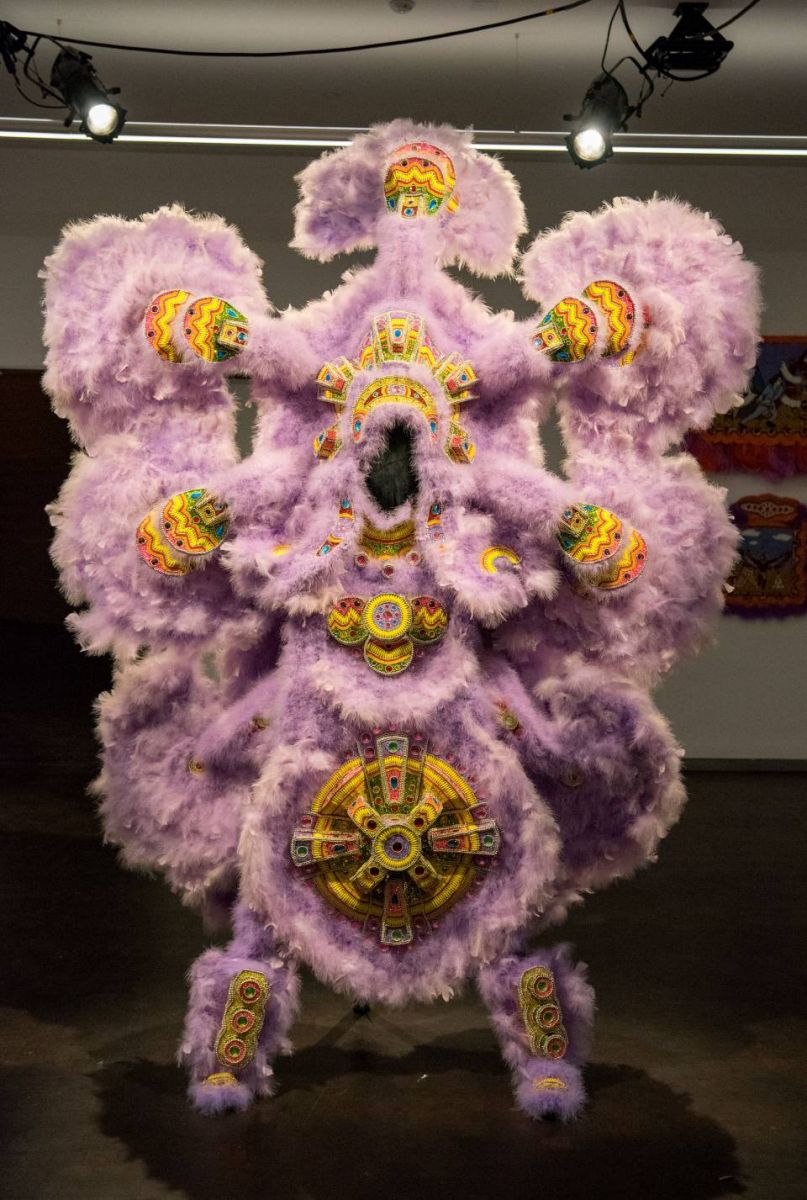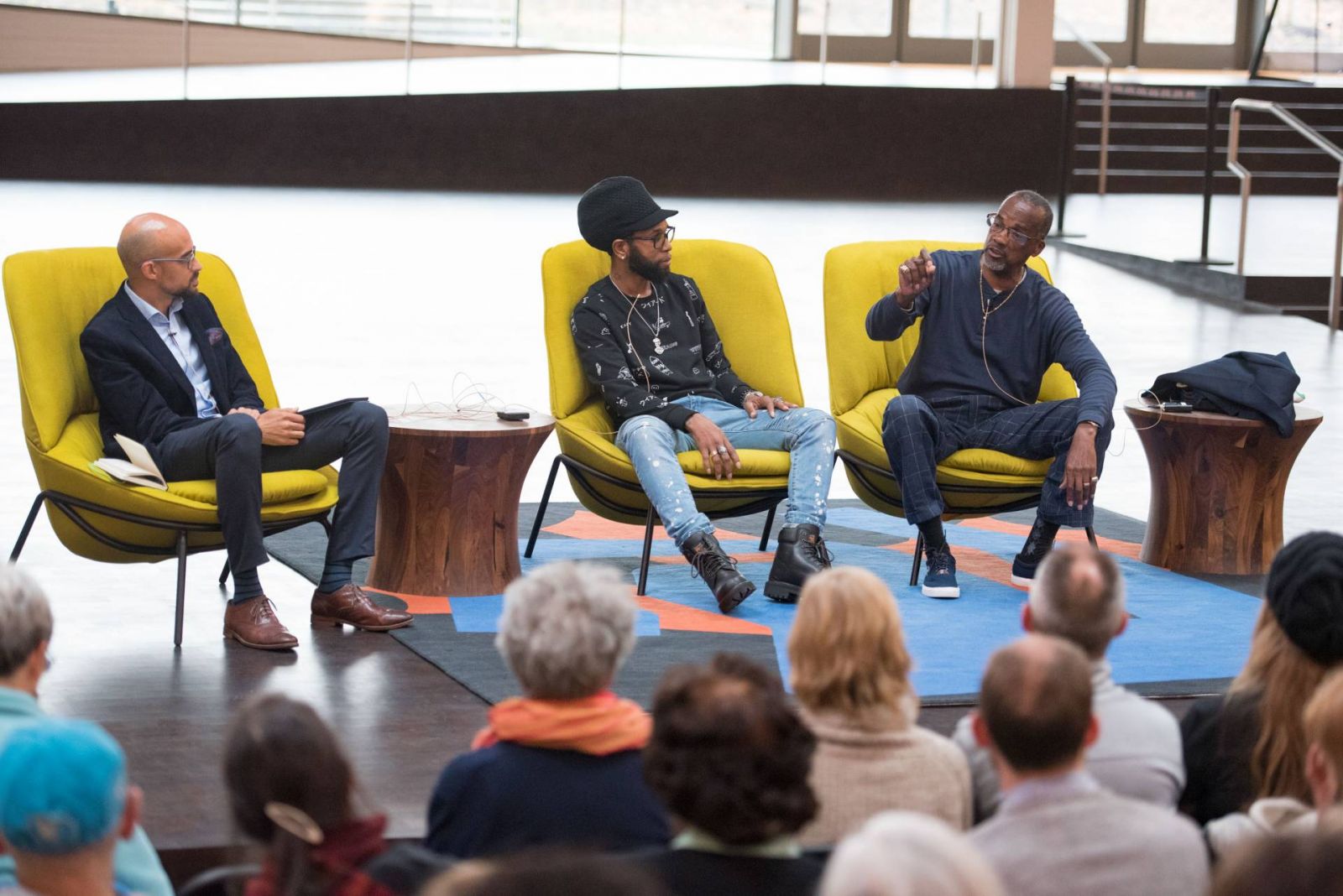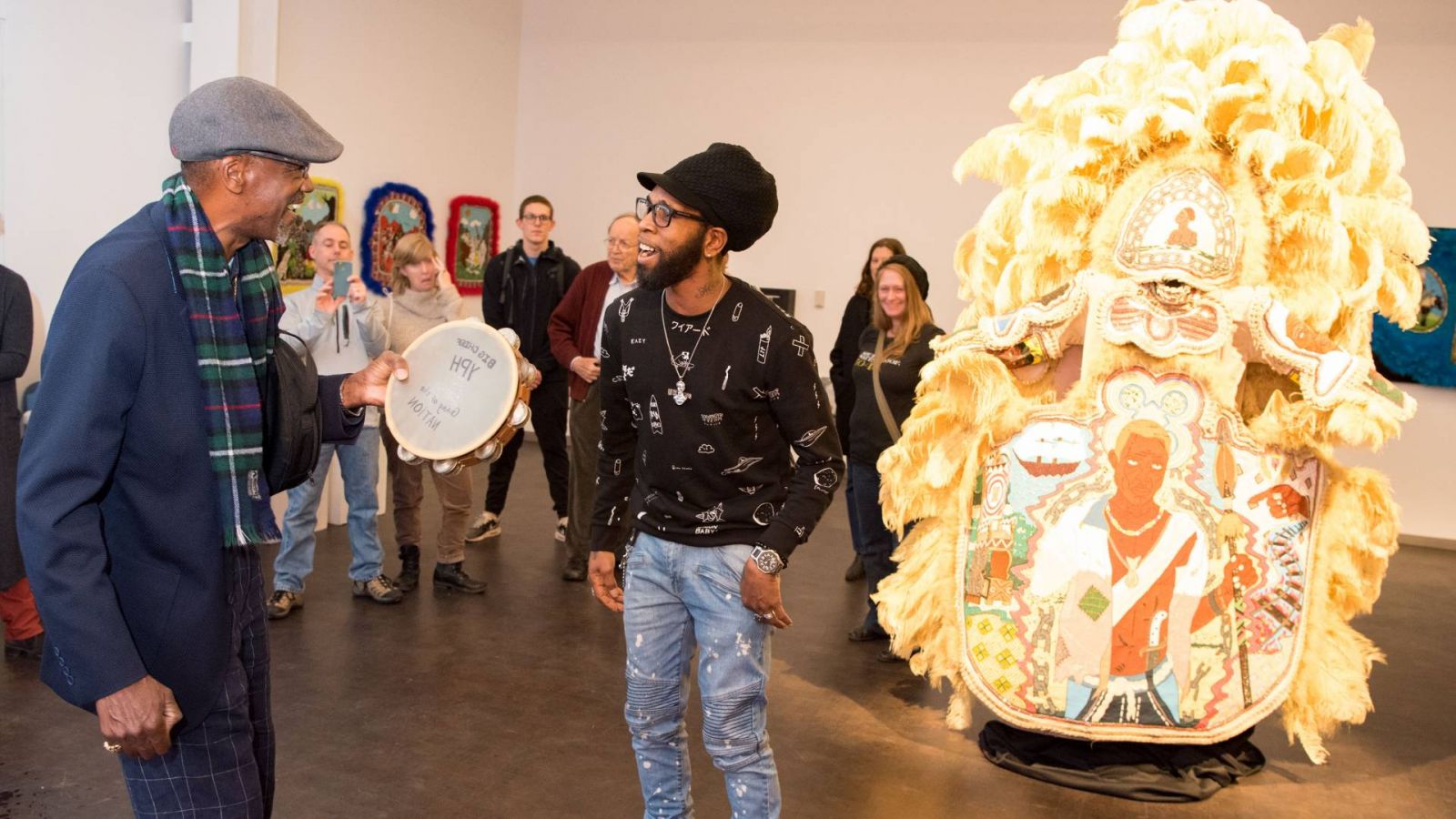New Orleans’ Black Masking Indian chiefs discuss art, community
Big Chief Darryl Montana and Chief Demond Melancon of New Orleans’ Black Masking Indian groups visited Princeton for an April 3 panel discussion on the artistry and passion behind the tradition, and met with students in two courses the next day. Their visit was part of the exhibition, “Big Chief Wears a Golden Crown,” organized by PEI associated faculty Jeff Whetstone in connection to his PEI Urban Grand Challenges project, “Flow: Living with the Mississippi.”
In a panel discussion held April 3 at Princeton University, two “big chiefs” of New Orleans’ Black Masking Indian groups explored the complex artistry and deep-seated community of the Black Masking tradition.
Chief Demond Melancon of the Young Seminole Hunters and Big Chief Darryl Montana of the Yellow Pocahontas Hunters are leaders of two of these groups, known popularly as Mardi Gras Indians. Referred to as “tribes,” the groups organize by neighborhood and perform during Mardi Gras (or Carnival) and other celebratory occasions wearing these intricately beaded and decorated suits. This process of creating elaborate ceremonial suits and aprons originated by African Americans almost 200 years ago to pay homage to American Indians and tell visual stories of hardship and redemption.
The discussion took place in the Forum of the new Lewis Arts complex in conjunction with the exhibition, “Big Chief Wears a Golden Crown: Art of the New Orleans Black Masking Indians,” which features two ceremonial suits created by Melancon and Montana as well as other Black Masking artwork. The exhibition is co-sponsored by the Princeton Environmental Institute and on view through April 7 in the CoLab gallery space. The panel and exhibition were organized by PEI associated faculty Jeff Whetstone, professor of visual arts in the Lewis Center for the Arts, in connection to his PEI Urban Grand Challenges project, “Flow: Living with the Mississippi,” which focuses on climate and the fate of New Orleans. The discussion was led by Joshua Guild, associate professor of history and African American studies.
On April 4, Melancon and Montana also met with students in the spring course related to Whetstone’s project, “The Port of New Orleans: Culture and Climate Change,” as well as with students Guild’s course, “New Orleans at 300.” Whetstone’s class had recently spent spring break in New Orleans visiting sites of artistic and scientific intervention to gain insight into how cooperation between cultural and scientific communities can provide valuable, sustainable strategies.


During a reception preceding the panel discussion, the chiefs detailed the craftsmanship that goes into the suits, which weigh over 100 pounds and can take up to 5,000 hours to construct. Standing in front of a bright yellow suit he created in 2015, Melancon explained that he and his wife, Alicia Winding, who was also at the reception, work for an entire year on each suit, which is only used for one year. The 2015 suit — made of intricate beadwork, rhinestones, feathers, marabou, fabric ruffles and other materials — tells the narrative of “Bras Coupé,” or “one-armed bandit,” a nickname drawn from the literal French translation “arm that is cut.” Bras Coupé was a famous cult hero to slaves of the South and lost an arm in 1834 when he was shot in a swamp by whites who thought he was a runaway slave.
“Each year, we create a suit with a different narrative of African indigenous peoples and slavery,” Melancon said. The suits depict actual and imagined events from African and American history and are worn on Mardi Gras, the “Super Sunday” Uptown and Downtown parades, and St. Joseph’s Day on March 19.
In the gallery space, Montana and Melancon led the crowd in chanting — clapping, dancing and banging on a tambourine — to demonstrate the traditional song that is performed at the beginning and end of each parade. Several onlookers recorded the joyful dancing on their cellphones.
Montana said he learned beading at age of 6 at the side of his father, the late Allison “Tootie” Montana, also known as the Mardi Gras Chief of Chiefs. Together, they made more than 100 suits. Putting his arm around Melancon’s shoulder, Montana lauded the younger chief’s artistry. “I’ve been watching Demond for 22 years,” Montana told the crowd. “I call him the ‘bead master’ — I say that with love. I am so proud of him.”
Montana explained that the tradition of “masking Indian” began generations ago in the late 1800s by the Montana family to change the culture during Carnival. He said the competition among tribes used to be manifested in physical fighting but now, with dressing, “it is like fighting with a needle and thread, a real competition.” Montana announced to the crowd that he has invited Melancon to collaborate with him on a new suit, a melding of their artistry. “I want him to bead my sleeves,” Montana said. “Then the city is his!”
After the crowd moved into the Forum, Whetstone introduced the panelists, noting that New Orleans is decades ahead of any other U.S. city with respect to climate change.
“In this regard, it is a prophetic city. … From the catastrophe of colonialism and slavery to the havoc wreaked by broken levees during Katrina, and the BP oil spill, the city still remains vibrant and resilient through it all — largely due to the strength and values fostered by the black communities of the city. Masking Indians have been reminding their neighborhoods for over 150 years that in the face of crisis, power and strength, resistance and resilience can be distilled from beauty.”


He said the beauty of the art and performance of the Black Masking Indians of New Orleans “is the driving force that forms communities of strength.”
Noting the unique artistic talents of Montana and Melancon, Guild said, “Princeton regularly hosts Pulitzer Prize winners and others. But there are no artists greater than these two.”
Guild said that Montana has taught over 3,000 students and, as he nears retirement, is mentoring Melancon, a multidisciplinary contemporary artist and performer. “I don’t want to take my art to the grave, that’s why I want to teach Demond,” Montana said.
Melancon said Montana “showed me the discipline of the culture, my coming into the Indian culture. When I do this, I channel Montana. My inspiration is always Montana.”
Melancon, who was born in 1978 and grew up in the Lower Ninth Ward of New Orleans, was first taught by prolific Mardi Gras Indian elders. In 2012, they declared that Melancon would be known as Big Chief Demond Melancon of the Young Seminole Hunters, his own tribe based in the Lower Ninth Ward.
Montana told the audience that the dressing tradition “is like an addiction, you can’t stop. It’s a beautiful thing, it brings community, family and friends together.”
Melancon acknowledged the threads of community and spirituality woven into the tradition. “My wife and I have been together 14 years. I taught her how to sew. And now I’ve taught my 13-year-old nephew. I teach them the culture, about Rastafarians, about indigenous peoples. When we make a suit, it becomes a study.
“Without the togetherness of family, you just can’t do it. I don’t even feel right sewing by myself. This is a blessing, to have my wife and family, my support runs deep. This is a spiritual thing. When I look at the years, looking back from Katrina to now, the love from everywhere, it makes you work harder.”


“Y’all going to hear me”
Montana and Melancon discussed the personal and mythical stories behind their suits when they met with students the next day. Melancon said his 2015 depiction of Bras Coupé featured in the exhibition was an act of rebellion against personal and social repressions at the time. Bras Coupé is a symbol of defiance, he said.
“When I went into this suit I was being rebellious. I said, ‘Y’all going to hear me, y’all going to feel me,'” Melancon said. “The story of Bras Coupé is deeper than deep for our city. He’s the reason we mask — he’s the reason we do this. The reason we have so much energy and feel so good when we’re out there is because we’re revolting against all the injustice in the world and in New Orleans.”
Black Masking is a form of communal resistance to poverty and, recently, to gentrification, which is is displacing New Orleans’ long-time black communities such as the Ninth Ward, Montana said. “In spite of the poverty of our city, they’re still a proud people because they got their culture,” he said. “When you can create something with your hands and bring smiles, joy and excitement to your community then you’re doing a good job. That’s what I try to do.”
For all the time that making the suits demands, they deteriorate quickly and are rarely seen after they’re worn, said Montana, whose house is filled with suits from his 48 years of crafting them. Exhibitions such as the one at Princeton makes the effort more worthwhile and ensures that the suits’ stories reach beyond New Orleans, said Melancon, who has sacrificed jobs and homes for his passion.


“I keep doing these suits and I keep losing,” said Melancon, who was sewing a new design as he spoke with the students. “If we just leave them in the Ninth Ward, they’re just going to sit there. People need to see them and understand the culture and the love in New Orleans. You don’t get that culture anywhere else. We got to keep on moving with these pieces and show them to the world.”
Gabriella Chu, a senior in Whetstone’s class, asked about the spiritual connection to masking, which Montana and Melancon described as a mystical experience, a powerful force that keeps them going. “It’s some kind of spirit that comes over me and it’s serious,” Melancon said.
“It’s got to be a spiritual thing because you don’t really have a life — this is your life,” Montana said. “This thing here, it’s not for everybody. It stays with you 24-7. It never leaves.”
As a boy, Montana didn’t think men could cry, he said, but the spirit of masking often brings him to tears, as it did his father and others involved in the tradition. While talking about his reputation for making masking-suit headdresses — or crowns — Montana suddenly teared up. “You ask anyone in New Orleans who’s known for crowns … see that,” he said as tears welled in his eyes.
“He’s got the spirit,” Melancon said. “That’s the spirit right there, that’s the sprit.”
“Sorry, y’all,” Montana said as he removed his glasses then pulled a white handkerchief from his pocket and pressed it to his eyes.






